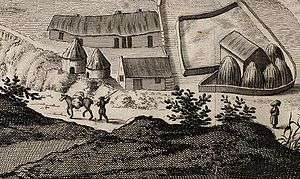Lowland Clearances

The Lowland Clearances were one of the results of the Scottish Agricultural Revolution, which changed the traditional system of agriculture which had existed in Lowland Scotland in the seventeenth century. Thousands of cottars and tenant farmers from the southern counties (Lowlands) of Scotland migrated from farms and small holdings they had occupied to the new industrial centres of Glasgow, Edinburgh and northern England or abroad, or remaining upon land though adapting to the Scottish Agricultural Revolution.
History
As farmland became more commercialised in Scotland during the 18th century, land was often rented through auctions. This led to an inflation of rents that priced many tenants out of the market.[1] Furthermore, changes in agricultural practice meant the replacement of part-time labourer or subtenants (known as cottars, cottagers, or bondsmen) with full-time agricultural labourers who lived either on the main farm or in rented accommodation in growing or newly founded villages. This led many contemporary writers and modern historians to associate the Agricultural Revolution with the disappearance of cottars and their way of life from many parts of the southern Scotland.
Many small settlements were torn down, their occupants moved to new, purposely-built villages. John Cockburn of Ormiston, for example, displaced cottars to the outskirts of his new ranch. Other displaced farmers moved to the new industrial centres of Glasgow, Edinburgh and northern England. In other areas, such as the southwest, landowners offered low rents and nearby employment to tenants they deemed to be respectable.[2] Between 1760 and 1830, many tens of thousands of Lowland Scots emigrated mainly within Lowland Scotland, with some taking advantage of the many new opportunities offered in Canada (and the United States after 1776) to own and farm their own land.[1] Most chose to remain, by choice, some out of an inability to secure transatlantic passage, or because of obligations in Scotland.
Although the causes were different, the lowland Agricultural Revolution is seen by some as the forerunner of the more brutual late stages of the Highland Clearances, especially because the notorious Patrick Sellar was a lowland emigrant. It had its genesis in the mid-18th century to the 1890s too, though specifically it includes the wholescale replacement of Highland agricultural labour or practice with Lowland, sometimes English, sheep farmhands or practice. New research (2003–04) about the destruction of Lowland culture has led historians such as Tom Devine to dub this period of time the Lowland Clearances.[3]
See also
References
- 1 2 bbc.co.uk: "Scotland's forgotten clearances" 16 May 2003
- ↑ Eric Richards, "Emigration from Scotland between the Wars: Opportunity of Exile?", International Migration Review, Vol. 34, No. 3, pp. 113-116. Autumn, 2000.
- ↑ Robert Allan Houston and Ian D. Whyte, Scottish Society, 1500-1800, Cambridge University Press, 2005, ISBN 0-521-89167-1, ISBN 978-0-521-89167-7, pp. 148-151.
Further reading
- Aitchison, Pete and Cassell, Andrew. The Lowland Clearances, Scotland's Silent Revolution: 1760–1830, 2003
- Devine, T. M. Scottish Nation: 1700–2000, 2001
- Gibson, Alex, 1990. ‘Proletarianization? The Transition to Full-Time Labour on a Scottish Estate, 1723–1787’. Continuity and Change, 5 (3): 357–89.
- Orr, Alistair, 1984. ‘Farm Servants and Farm Labour in the Forth Valley and South-East Lowlands’. In Farm Servants and Labour in Lowland Scotland, 1770–1914.
